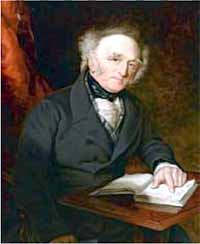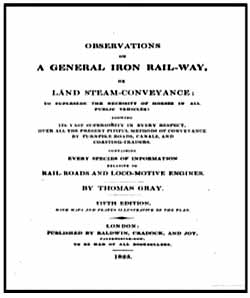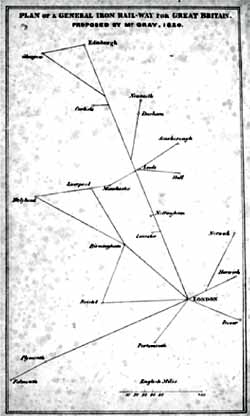Articles from the Thoroton Society Newsletter
Thomas Gray (c1787 - 1848) : The Railway Visionary
By Keith Fisher
 Thomas Gray (c1787 -1848)
Thomas Gray (c1787 -1848)Painting by Richard Augustus Clack (1801 - 1880), Royal Albert Memorial Museum & Art Gallery, Exeter, Devon
It must first be stated that Gray was not a Nottingham man, he was born c1787 in Leeds, West Yorkshire, son of Robert Gray, a glass merchant. He was sometimes referred to as ‘of Nottingham’ as it was while he was living in the town that he published the final copy of his ‘Observations on a General Iron Railway.’ Thomas’s obsession with steam railroads is believed to originate from him seeing the Middleton Railway. This railway, which was founded in 1758, transported coal from the Middleton colliery, south of Leeds, four and a half miles to a staithe on the river Aire near the town bridge. It was originally a wooden tramway. But in 1812 the two flatter sections of the line were converted to be hauled by steam. This was the first successful commercial steam railway, thirteen years before the Stockton and Darlington opened. Middleton railway is a map of the Leeds area, surveyed around 1820, which shows a glass works at Hunslet right next to the line.
Gray was a much-travelled man, almost certainly on behalf of his father’s glass business. When he married Rose Hill in Woodford, Essex in 1813 he recorded his parish as Oporto, Portugal. Their daughter Elizabeth was born in Wanstead Essex, in 1815, and Thomas was entered as ‘a Merchant’ in the parish register. The next year he was in Belgium where he lived until the early 1820s; as his daughter Rose was born there c 1821. This was a turbulent period for the country. After the Napoleonic Wars the Congress of Vienna created the Kingdom of the Netherlands combining the Protestant Netherlands with Catholic Belgium. He was in Brussels in 1816, when a projected canal from Charleroi, in Belgium, to Holland, a province of the Netherlands, was proposed. In conjunction with the expatriate John Cockerill, he urged that a railway should be built instead. They were unsuccessful and Belgium had to wait another twenty years for its railways. It was from this period that Gray became fixated with his vision of planned railway systems. In 1818 he was living in Etterbeek, near Brussels, with his brother and their families.He gave to a friend, Thomas Wilson, a package saying, ‘Here is the main-spring of the civilisation of the world; all distances shall disappear; people will come here from all parts of the continent without danger and without fatigue; distances will be reduced one-half; companies will be formed, immense capitals paid and invested; the system shall extend over all countries; emperors, kings, and governments will be its defenders: and the discovery will be put on a par with that of printing.’Inside the package was ‘Observations on a Railroad for the Whole of Europe.’ Gray returned to England and settled in Nottingham for several years.
 Poster for ‘Observations on a General Iron Railway.’
Poster for ‘Observations on a General Iron Railway.’He published his first ‘Observations on a General Iron Railway or Land Steam-Conveyance’ advocating an integrated steam railway in Great Britain in 1820. This was published anonymously and was quite short, 22 pages. By his last, Fifth, edition, published in 1825, while he was in Nottingham, it had expanded to over 200 pages. His concept, in essence, was of a government built, owned, and controlled, network of mainline railways. This system linked the twenty-two major cities and ports of the day. Routes radiated from London to Edinburgh and the ports of Falmouth, Dover, Bristol, Liverpool, Holyhead, Hull, Harwich, and Scarborough. He also incorporated cross country links including between Hull and Liverpool. One of the inland towns was Nottingham. From this central system privately owned branch lines would connect to the rest of the country. His reasons for this concept are stated on the title page of the publication; ‘Its vast superiority in every respect over all the present pitiful methods of conveyance by turnpike roads, canals and coasting-traders. ’It should be noted that Gray was not the first to advocate a national railway system. Benjamin Outram 1764-1805, the canal, and railway engineer who founded, what became, the Butterley Company, proposed double tracked intercity railways from ‘London to Bath and every other part of the country’ in around 1802. Also, in that year Richard Lovell Edgeworth wrote a paper, ‘On the Practicability and Advantage of a Central System of Railroads’. Other published visionaries were Richard Phillips in 1813 and Richard Preston in 1816. The difference with Gray is that he was a monomaniac who apparently talked of nothing but railways. Although he was mocked at the time, he had many prescient ideas about the opportunities afforded by a national railway network. He saw its advantages for the coal trade, especially to London, but he also understood the effect that fast reliable transportation would have on the fresh food industries of farmers and fishermen. He foresaw mail trains, commuting into large conurbations and even seaside excursions. Not all his reasons for advocating the railway were entirely financial. Building the system would provide work for the labouring classes. It would also reduce the need for hundreds of thousands of overworked horses. The horses used by stagecoaches were ‘lucky’ to last three years.
 Gray's 'Plan of a General Iron Rail-way for Great Britain (1920)'
Gray's 'Plan of a General Iron Rail-way for Great Britain (1920)'While in Nottingham, where his daughter Cecilia was baptised in 1826, he became a member of Bromley House Library. He was a member from 1824 until 1829 and on the Committee in 1826 and 1827. He probably lived with his relations as, in ‘Glover’s Nottingham Directory’ of 1825, there is an entry; Gray, Robert and James William, glass merchants, Canal Street. Thomas conducted a relentless campaign to promote his idea. He petitioned anyone he could think of, including Prime Ministers, the House of Commons, the Home Office, and the Board of Agriculture. He also wrote endless letters to the newspapers. It perhaps did not help his cause that he tended to speak his mind. In a letter to the Nottingham Review in 1828 about the London Coal Trade he wrote, ‘The proprietors of the northern collieries will, however, find their opposition of no avail. - Do they suppose that their selfish arguments can weigh a feather against the overwhelming influence of the inhabitants of the metropolis, and of all towns in the south of England? - Will they dare to erect their puny heads against such a phalanx?’ Thomas was no diplomat. By 1832 Thomas had moved to Exeter. Again, it seems that it was to be with family, perhaps because of a dispute, as Robert and James William Gray had dissolved their partnership in 1830. James William was a lead and glass merchant in Exeter until at least 1837, when he was declared bankrupt. Thomas lived in the district for the rest of his days, trading as a glass dealer ‘on commission.’ By the mid-1840s, during the ‘Railway Mania’, Thomas’s contribution was beginning to be acknowledged. At the dinner to celebrate the opening of the Nottingham and Lincoln Railway in 1846, ‘Union jacks and small flags bearing the names of Thomas Gray, the railroad pioneer, and of our first-rate engineers, &c., graced the walls.’ The fact that Thomas had made no money from his efforts and that he was living in straitened circumstances prompted efforts to provide him with a testimonial, for which subscriptions were taken. One of his champions was William Howitt, the well-known Nottingham writer who had met Thomas when he was a Bromley House member. They had both been on the library committee in 1826. In early 1848 a portrait of Thomas by Richard Augustus Clack was commissioned. The painting was to be lithographed and proceeds of the engravings destined for the Gray Testimonial Fund. The striking picture shows Thomas seated at a table with his hand on a book. The book is open at his ‘Plan of a General Iron Rail-way for Great Britain.’ Thomas died later that year. ‘No prophet is accepted in his own country’ (Luke 4:24). Thomas Gray may not have been appreciated in Great Britain but the same is not true in Belgium. There is a street named after him in Etterbeek, the ‘Rue Gray’. In 1847 a Belgium locomotive was named ‘Thomas Gray’, and a year later contribution boxes for his testimonial were placed in their railway stations. After Belgium's independence in 1830 the country invested heavily in a national and nationalised railway system. The first line opened in 1835 with three locomotives supplied by Robert Stephenson. In the same year John Cockerill (1790-1840), Gray’s old friend from 1816, built the first steam railway locomotive in Belgium, ‘Le Belge’, to a design by Stephenson. Cockerill, who was a banker and industrialist, probably influenced the early development of the system, based on Gray’s ideas. Nearly twenty years (1866) after Gray's death an anonymous article, defending him, appeared in Charles Dickens’s periodical ‘All the Year Round’. The title of the piece was ‘Not Quite a Man for a Strait-Jacket’ was a reaction to the Samuel Smiles book on George Stephenson. The writer stated that he had known Gray forty years before and noted that the ‘Edinburgh Review’ had said ‘of this Thomas Gray, with his one idea? Put him in a straight jacket.’ He also rebuffed the arguments in Smiles book, ‘Truly, when Mr Smiles says that Stephenson was the creator of the railway system, and not Gray, we must answer yes, exactly as the builder of St Pauls was the creator of it and not Sir Christopher Wren.’ Recently the identity of Gray’s advocate has been discovered by a bookdealer named Jeremy Parrott. It was William Howitt (1792-1879). Howitt, of course, knew Gray from their Bromley House days.The description of his first impressions of the visionary is worth repeating. ‘Little more than forty years ago, when living in Nottingham, I frequently observed, passing to and fro in the streets a grave, middle sized, middle aged man, having something sufficiently peculiar in his costume to mark him out from the mass. He was, as I recollect him, of a muscular but active build, of a somewhat dark complexion, dark hair becoming grizzled, face lines good, earnest and expressive, but with a solemnity in them that betoken a mind seriously engaged in some important object. He wore a hat, broad in the brim and low in the crown, and altogether gave the impression that he was a half-pay naval lieutenant.’
< Previous